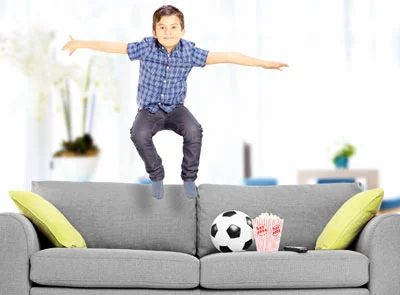Jumping on the Couch

Dear Dr. Mary and Lynn:
We have been using the "time out" discipline method for our spirited 27-month-old. An example is that he loves to jump on our couch, which is obviously dangerous. When I see that I tell him that I'm counting to three and then he's going to get a time out if he's still jumping when I get to three. He'll laugh, count to three with me and then run into his bedroom shouting happily "TIME OUT!" and shut the door. Two minutes later when I open the door, he's sitting in the rocking chair happily reading "Pete the Cat" to himself. It doesn't seem like the time-out method is eliciting the reaction we were looking for and it doesn't seem like much of a punishment for him. Since we've been warned time and time again about not using corporal punishment, I'm just not sure what our other options are. Would love your help! -Susan
Dear Susan:
We love your son’s spirit! What’s important to remember about toddlers is that everything in their brain is telling them, “Do it! Try it! Find out what will happen!” That’s why words alone will never stop them.
Next time you see him jumping on the couch, go to him. Let him know that you see he needs to jump. Understand that he likes that hard sensory input from jumping. This is a good thing. You just don’t want him jumping on the couch. So instead of sending him to time-out re-direct him to a mini bouncer, a cushion on the floor or some other suitable place for him to jump. Once you’ve established the acceptable place anytime he begins jumping somewhere else, redirect him to that mini bouncer or cushion. You might also help him “remember” by downloading the image of stop sign from the internet, printing it out and putting it on your couch for him to see. Visual reminders really make a difference.
The second thing to remember is that the purpose of a time out is to take a break and calm down. It’s a tool for helping a child move from the “red zone” of tense energy to the “green zone” of calm energy, rather than to punish or make him suffer. We realize this is different from the idea of “go rot and be miserable in your room for a while.” And that’s why for us, time out means take a break in a comfortable spot, look at a book and when you are calm come back to work this through. He doesn’t have to be miserable. Once he is calm then you can do a “redo” teaching him the words and actions you want him to use instead of those he did. Learning doesn’t come from forced separation or punishment. Learning comes from knowing what to say or do that would be more appropriate. The “redo” is where the learning is not isolation or tears.
Display All Posts
Search by Topic:
Popular Posts:
- When your child yells at you: Expecting and Coaching respectful behavior
- 5 Tips to Stop the 'Strike out Tantrums:' Hitting, Biting, Kicking and Name-calling
- Why is my child suddenly clingy?
- Ten Steps to a Peaceful Bedtime for Your Spirited Child
- When Your Child’s Meltdowns are Ruining Vacation






